
B369-Young-Learners-Activity-Book_v10
.pdf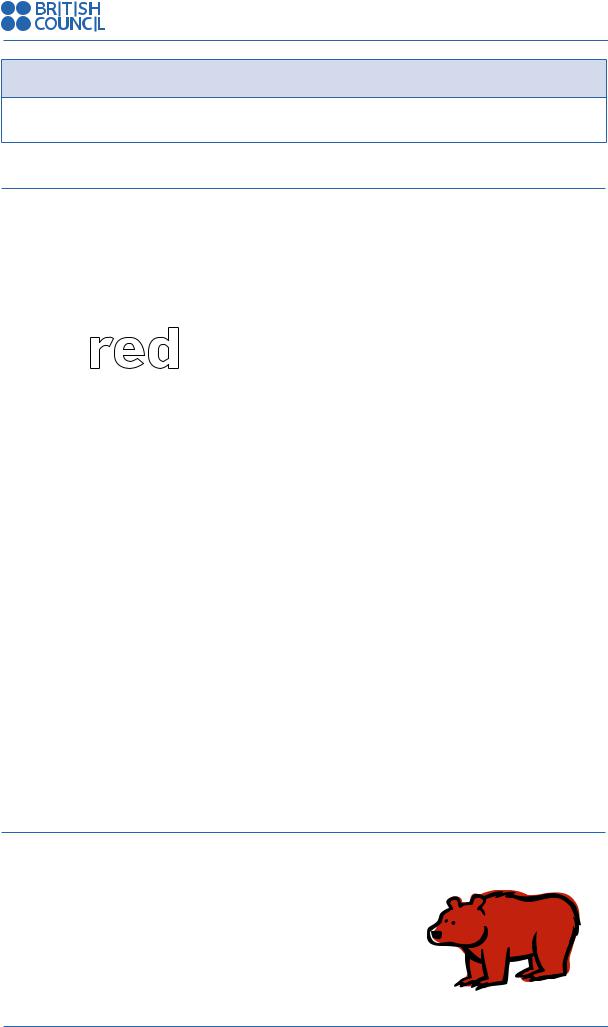
TeachingEnglish Young Learners Activity Book
Activities
Notes
There are a number of activities here and so it is probably better to carry them out over a series of lessons rather than in one lesson.
Alternatives
•Rather than each group responding one by one to the question, ‘Brown bear, brown bear
what do you see?’, children can make a chain by trying to remember what animals went before, for example, ‘I see a red bird, a yellow duck, a blue horse and a green frog looking at me!’.
•After they have stuck the pictures into the booklets, the children can then write the story out, or you can give the children the sentences to stick in next to the right picture (depending on age). You can write the colour in blocks that children can fill in with the right colour:
I see a |
bird looking at me. |
•A similar set of steps can be carried out with lots of story books written for children. You can use The Very Hungry Caterpillar (Eric Cayle); A Squash and A Squeeze (Julia Donaldson and Axel Scheffler); There was an old woman who swallowed a fly (Pam Adams); We’re Going on a Bear Hunt (Michael Rosen). You can also find stories on www.bbc.co.uk/cbeebies/stories/
•Yulia Sharma (Ukraine) suggests another brown bear activity that could be used in conjunction with this story, when you think that the children are getting restless.
1.Ask the children to stand up. Take them to a corner of the classroom and say that a brown bear is sleeping there. Tell the children that they must be very quiet because they must not wake the bear. If they wake the bear, he will chase them.
2.Ask the children if they like berries and if they like mushrooms. Tell them you are going to pick mushrooms and berries which are to be found near the brown bear. If the bear wakes up, they must return home to their chairs quickly so that the bear does not catch them.
3.Teach the children the rhyme about the brown bear: Mushrooms, berries, one two three
Brown bear, brown bear, don’t catch me!
4.Take the children as far away from the brown bear’s lair as possible and with them slowly start moving towards the bear, chanting the rhyme. Pretend to pick mushrooms and berries. When you are near the lair, chant the rhyme very quietly. When you are very close, and on ’don’t catch me!’, grab a teddy bear you have hidden in the lair and start to chase the children. The child you catch then becomes the bear when you repeat the activity.
No resources?
You will need to know a story if you do not have a book to read. Ask children some questions about the subject of the story to begin and then tell the story. You will need to use gestures instead of pictures. So if you know the Brown Bear story, you can
mime a bear, do a gesture for ‘see’ and then mime the other animals/people. Instead of flashcards, children also mime in groups. Go straight to the booklet making stage, but instead of sticking in pictures, children can draw them and colour them if they can.
Otherwise, they can write the colour on the picture.
© British Council 2012 |
19 |
|
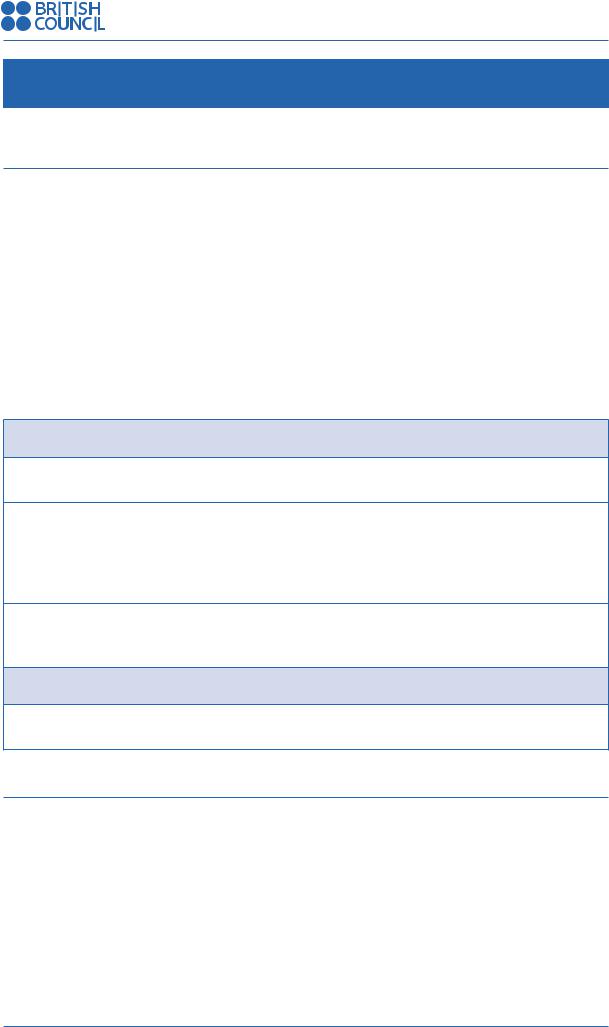
TeachingEnglish Young Learners Activity Book
Activities
Activity 7: Calendars
Giuliana Veruggio – Italy
Age: All ages  Maximum 15 minutes Large classes? Yes Mixed level? Yes
Maximum 15 minutes Large classes? Yes Mixed level? Yes
Materials: A calendar page for each child. Organisation: Individual work.
Aim: To revise vocabulary.
Description: In this activity the children decide what new language they want to remember. Each child is given a new calendar page at the beginning of each month. Over the month they fill in the spaces on the calendar with new words that they choose themselves.
Preparation: You will need to prepare a calendar page of the month for each child. You can make this on the computer or you can draw it. Make sure each square has a day and a number.
Procedure
1.At the beginning of each month, give each child a calendar page of the month with a square for each day.
2.Every Friday (or on whichever day you choose), ask the children to put a new English word, perhaps with a picture or a translation in each square for that week. The words can be from work covered in class or the children can ask you for words they would like to know in English. As the children are working on their calendar weeks, go around the class and ask them to pronounce the words and tell you what each word means.
3.At the end of the week, the children take their calendars home and learn the words
they have written down. By the end of each month, the children should have learnt about 30 new words and have a colourful record of their achievements.
Notes
This is an easy way to personalise learning as the children choose their own words to write in the squares. You can brighten up the classroom by displaying completed months on the walls.
Alternatives
•Children can write sentences instead of words.
•At the end of each week/month, the children can write a story, trying to include as many words as possible. You can give a prize for the best story.
•For more advanced learners, you can make the task more challenging by asking them to try to use words beginning with as many different letters of the alphabet as possible. You can give a prize to the child who uses the most different letters.
20 |
© British Council 2012 |
|

TeachingEnglish Young Learners Activity Book
Activities
No resources?
You can make a class calendar page or the children can draw a grid in their exercise books.
1 |
2 |
3 |
4 |
5 |
6 |
7 |
|
|
|
|
|
|
|
8 |
9 |
10 |
11 |
12 |
13 |
14 |
|
|
|
|
|
|
|
15 |
16 |
17 |
18 |
19 |
20 |
21 |
|
|
|
|
|
|
|
22 |
23 |
24 |
25 |
26 |
27 |
28 |
|
|
|
|
|
|
|
29 |
30 |
31 |
|
|
|
|
|
|
|
|
|
|
|
© British Council 2012 |
21 |
|
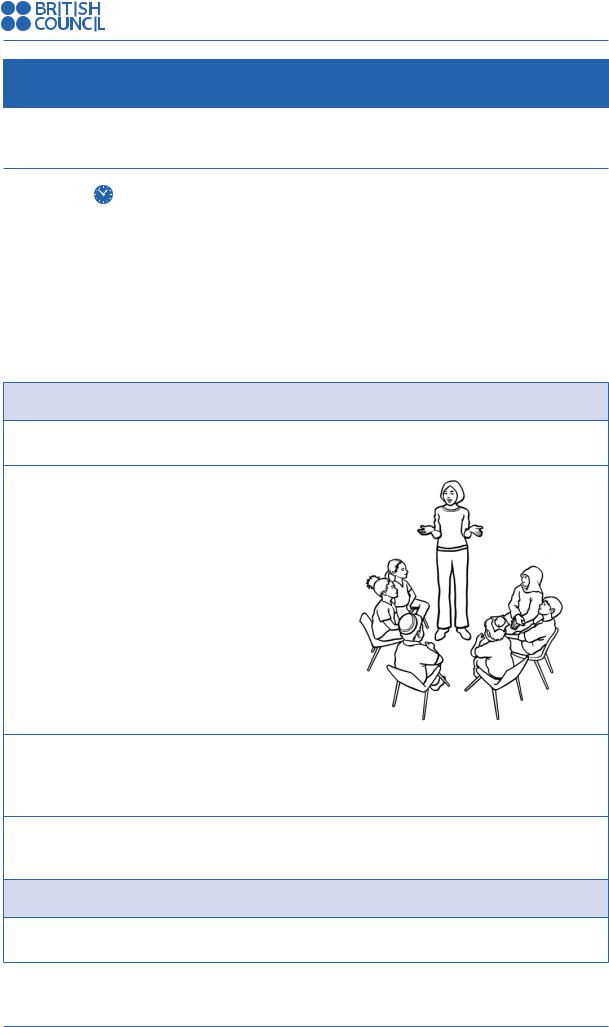
TeachingEnglish Young Learners Activity Book
Activities
Activity 8: Change places, please
Marianna Burlina – Italy
Age: All ages |
5–20 minutes Large classes? No Mixed level? Yes |
Materials: None. Organisation: Whole class.
Aim: To listen and respond to requests and to make requests.
Description: This is a whole class activity which involves children changing places in response to cues.
Preparation: No preparation is needed for this activity.
Procedure
1.Put all the chairs in a circle facing the middle. There should be chairs for all the children but not one for the teacher.
2.Stand in the middle of the circle of chairs and nominate two children to change places (for example, ‘Marco and Anna, change places please’)
3.When the children are used to moving around, say a sentence such as ‘If you have brown eyes, change places’. The children who have brown eyes get up and try to sit in another chair. While the children are moving, the teacher tries to find a chair. Someone will be left without a chair and this child then makes the next ‘change places please’ sentence.
4.At the end of the game, say ‘there will only be one more sentence’. At this point, the child who is in the middle can say, ‘If you are a teacher, change places, please’ making sure that the teacher always loses the game!
Notes
This activity is a great deal of fun but it also has the potential to be quite chaotic. Children love it but do be careful to avoid minor accidents!
22 |
© British Council 2012 |
|
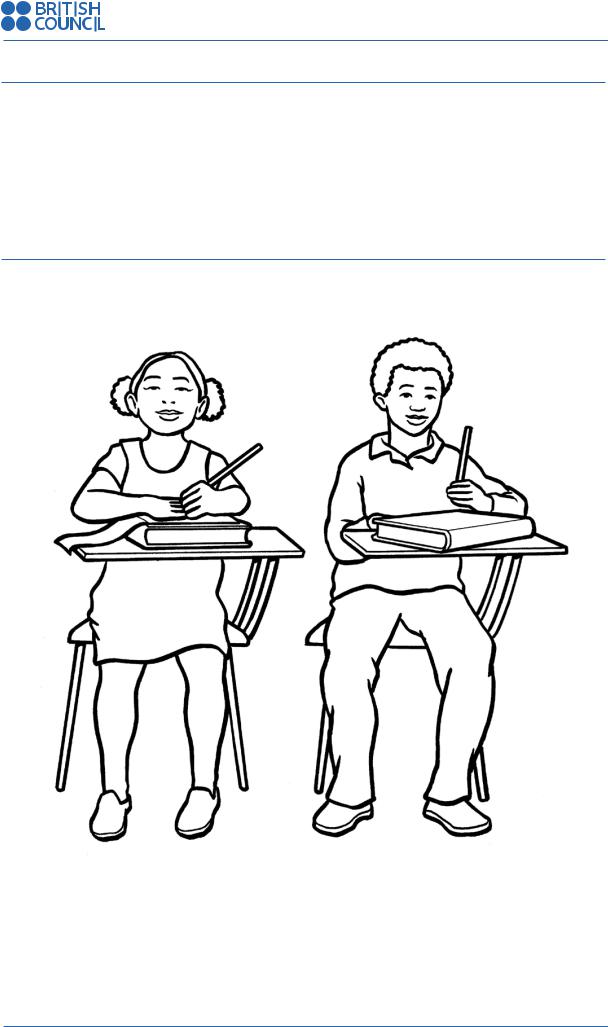
TeachingEnglish Young Learners Activity Book
Activities
Alternatives
•This game can be played in big groups if the children sit on the floor.
•The game can be played with low level children and simple vocabulary. For example, you can give the children names of fruits: four children are bananas; four apples; four mangos; four peaches; four melons and so on. The teacher is also a fruit. The teacher starts by saying ‘bananas and mangos’ and those children have to change places. To make it even more fun, you can introduce ‘fruit salad’ and all the children have to change places.
No resources?
No resources are needed for this activity.
© British Council 2012 |
23 |
|
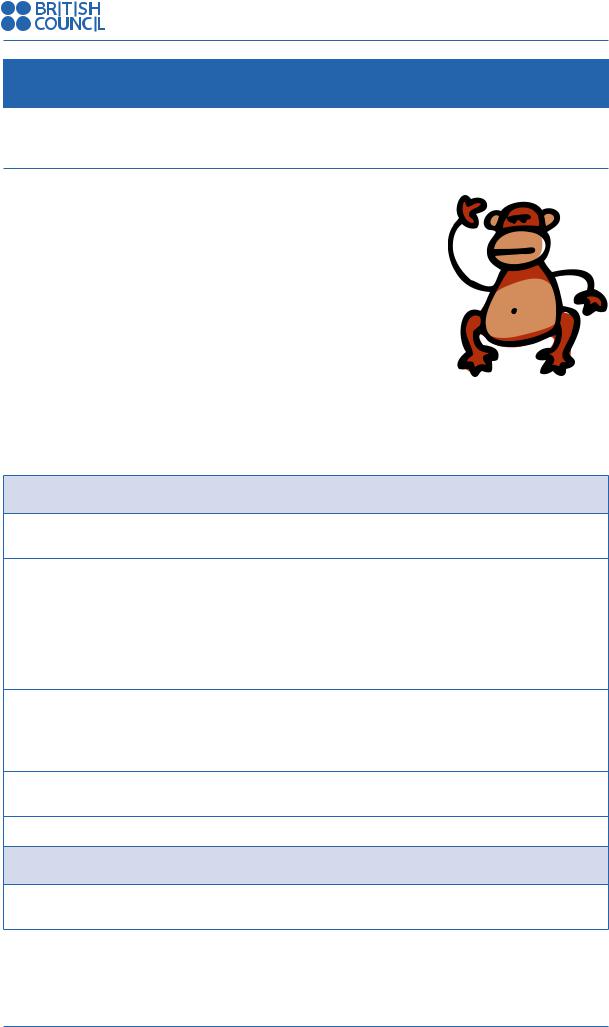
TeachingEnglish Young Learners Activity Book
Activities
Activity 9: Crazy animals
Sabrina De Vita – Argentina
Age: 9+  1 hour Large classes? No Mixed level? Yes
1 hour Large classes? No Mixed level? Yes
Materials: Computer with internet connection, digital pictures of animals.
Organisation: Individual, pair and group work. Aim: To describe characteristics of different animals.
Description: The children write texts about animals and then record their texts on the Blabberize website.
Preparation: You will need digital pictures of all the animals you use for the activity. If you need some pictures of wild animals, try: www.weforanimals.com/free-pictures/wild-animals/ or Google images
(www.google.com.ar/imghp?hl=es&tab=wi It is a good idea to familiarise yourself with the website and how it works before class.
Procedure
1.Divide the class into groups and assign an animal group to each (or the groups can choose). For example, insects, birds, reptiles and so on.
2.Ask a child to choose an animal from the assigned group. He or she then writes a short text about the animal, in the first person.
For example:
Hello! I am a crocodile. I live in the river and sleep a lot. I have a very big mouth and very sharp teeth so that I can catch and eat my dinner! I like sleeping and sleeping and sleeping. Sometimes other animals think I am a log.
3.When the texts are ready, the children take it in turns to upload the pictures and record the texts on Blabberize (blabberize.com). This site allows you to upload pictures which you can then make talk by manipulating the mouth on the picture and recording a message. The children should follow the very clear instructions on Blabberize to make their recordings.
4.The children can then share their Blabberize recordings with each other or post them as part of a class blog.
5.Watch the best (funniest!) recordings together as a class.
Notes
Of course websites can disappear without warning, but Blabberize has been going for quite some time and is a much used resource by teachers.
24 |
© British Council 2012 |
|
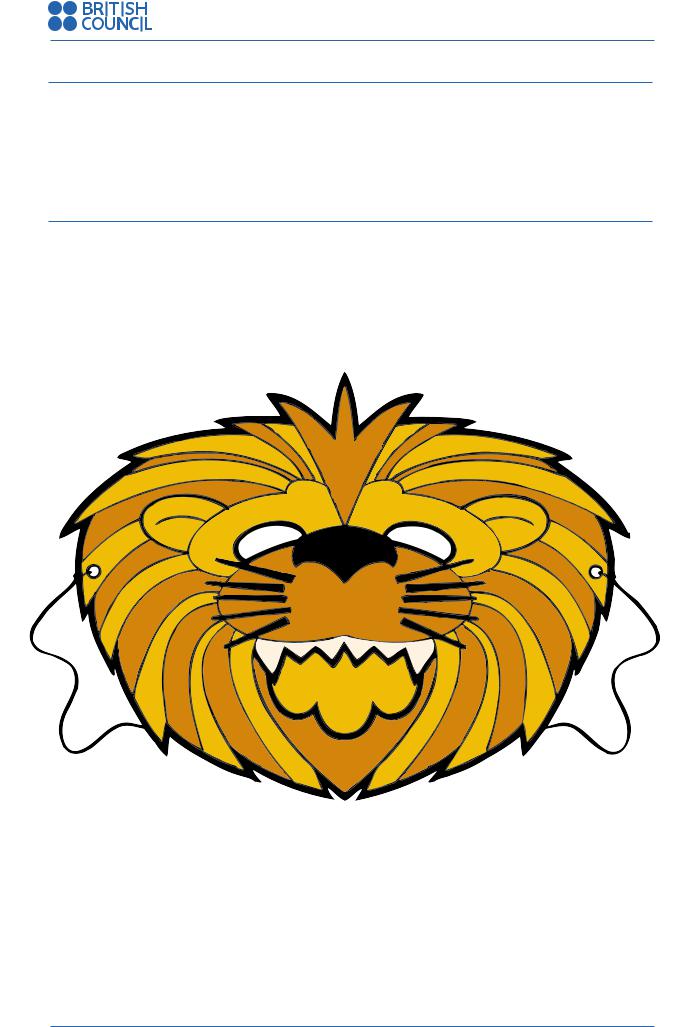
TeachingEnglish Young Learners Activity Book
Activities
Alternatives
•The children can make personal texts about themselves. Instead of uploading pictures of animals to the site, they can upload pictures of themselves instead.
•The children could also take on the roles of important world leaders, cultural icons, scientists in a similar way.
No resources?
If you do not have a computer, you will not be able to use the websites. However, the children can still choose an animal, write the text and read it to the class. You can encourage them to use ‘animal’ voices when they read.
If you have paper, pens, and string or wool, the children could also make an animal mask that they can put on while they are reading.
© British Council 2012 |
25 |
|
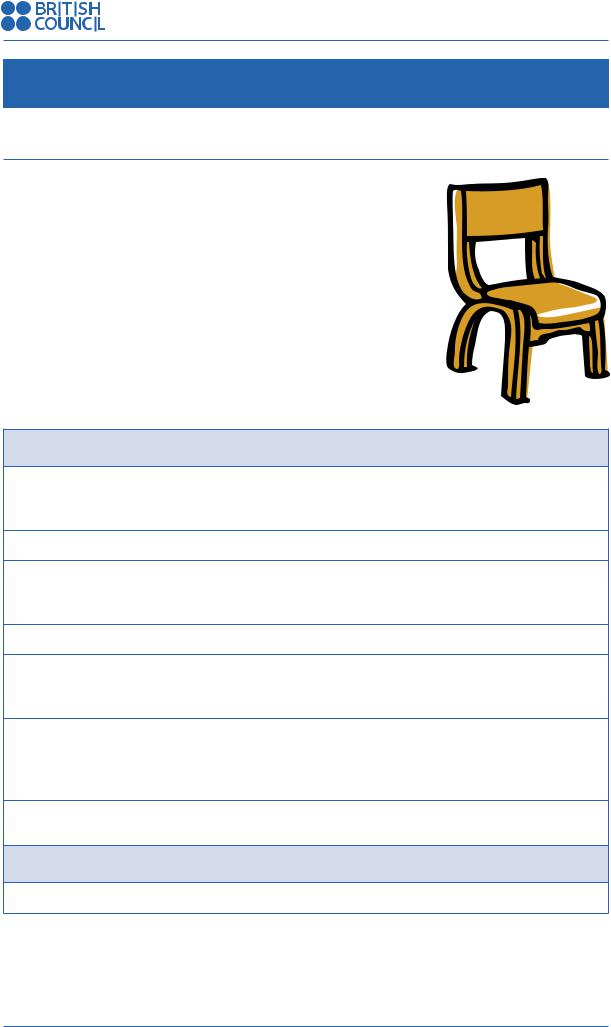
TeachingEnglish Young Learners Activity Book
Activities
Activity 10: Creative chairs
Silvana Rampone – Italy
Age: 6 –10  30+ minutes Large classes? No Mixed level? Yes
30+ minutes Large classes? No Mixed level? Yes
Materials: A4 paper, felt tip pens, scissors, glue, dance music and equipment to play it on.
Organisation: Group work and whole class. Aim: To practise speaking and writing.
Description: In this activity, children co-operate in drawing pictures, developing their creativity through collaborative work and also developing their communicative and thinking skills.
Preparation: You will need a piece of paper and a coloured pen for each child.
Procedure
1.Ask the children to place their chairs in a circle. Give one sheet of A4 paper and a felt tip pen to each child. Use as many different colours as possible. Tell the children to write their names on the back of their piece of paper.
2.Tell the children to sit on their chairs and to draw anything they like on the piece of paper.
3.Tell the children that when they hear music, they have to start dancing around the chairs. When the music stops, the children should stop and stand behind the nearest chair and draw another picture on the paper on the chair they are standing behind.
4.Start the music.
5.When the music stops, the children go to the nearest chair (not their own) and add a drawing to the paper they find there. Continue this procedure until you see that the papers are quite full of drawings.
6.Ask the children to go back to the chair they started from and look at the drawings. The children then take it in turns to hold up their pictures and describe what they see to
the rest of the class. They can use the chunk ‘I can see...’ to introduce the pictures. You can help them with any new words they need.
7.After describing their pictures, the children can then write a story, including as many of the pictures on the piece of paper as possible.
Notes
If you have a large class, you can organise the children into two or three circles.
26 |
© British Council 2012 |
|
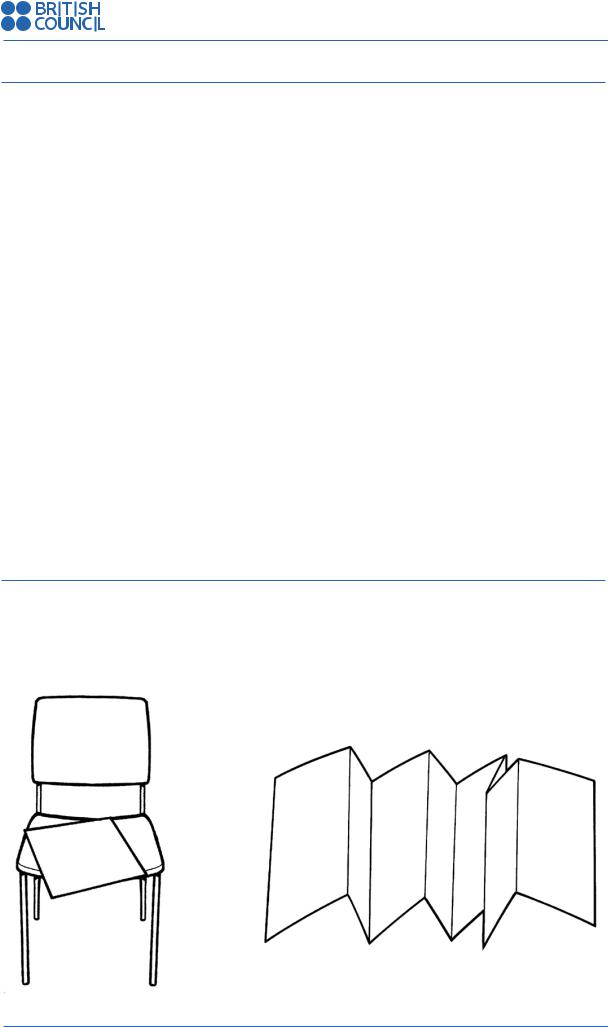
TeachingEnglish Young Learners Activity Book
Activities
Alternatives
•You can extend this by asking all the children to hold up their pens. The child describing the picture can identify who did the drawings and say ‘This is Davide’s picture’ or ‘Davide drew this picture’ or ‘This was done by Davide’ or whatever phrase might be useful for your class to practise.
•The children hold up their pictures for the class. Play the game ‘I spy’. Children take it in turns to say ‘I spy with my little eye ...’ finishing the sentence with the names of objects in the pictures, for example, ‘I spy with my little eye a flower’. The other children have to find all the pictures with flowers in them and point to them.
•The children cut out the objects from their drawings. Place all the cut out pictures on the floor and ask the children to sort them out so that all drawings of the same object are together (flowers, houses, people etc).
•Put a large poster-size sheet of paper on the floor or on a desk and ask the children to stick the objects on it to make a display using singular and plural forms. Write on the poster (or ask the children to write) one flower six flowers (depending on how many there are on the poster). Draw the children’s attention to any irregular plurals and how they are formed.
•Give each group a piece of poster-size paper. The children cut the objects out of their pictures and rearrange them on the poster, leaving some space at the bottom. When they’re happy with the layout, they can glue them onto the paper to make the new picture. The children can then colour the background, give their poster a title and write a short description of it at the bottom.
•The children make an accordion book of their story by sticking the pictures in the right sequence. (see diagram below). They then write short sentences for each stage
of the story.
No resources?
You can divide the board into different sections and instead of dancing around chairs, children just dance on the spot (you can sing or play an instrument, or nominate a child to do so). When the music stops, the children go to a section of the board and draw a picture. Repeat until all the children have drawn a picture in each of the sections.
© British Council 2012 |
27 |
|
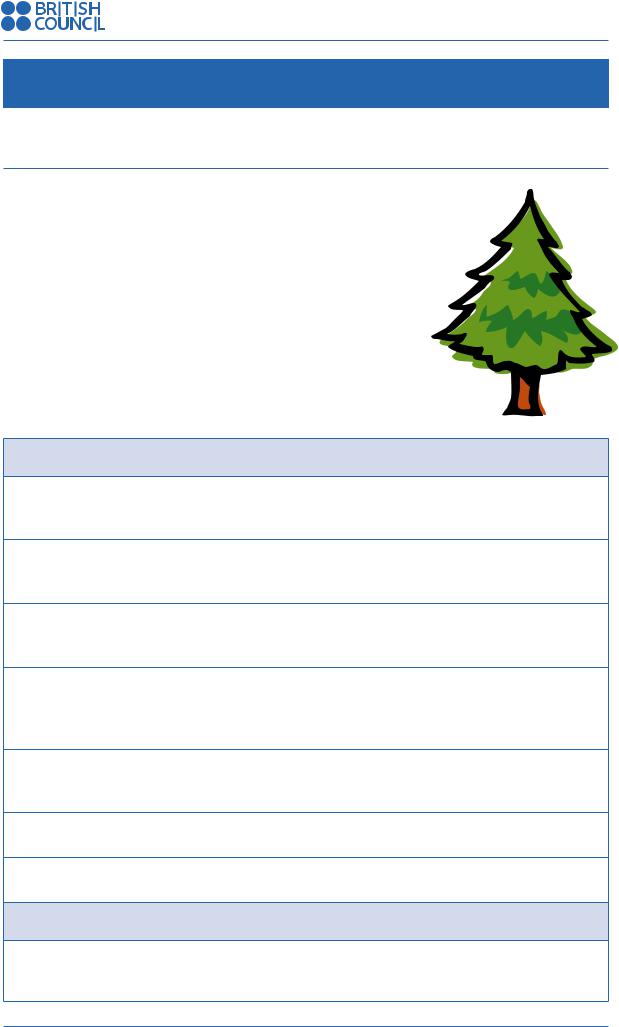
TeachingEnglish Young Learners Activity Book
Activities
Activity 11: Plants and seeds
Erica Cimarosti – Italy
Age: 9+  2 lessons Large classes? Yes Mixed level? Yes
2 lessons Large classes? Yes Mixed level? Yes
Materials: Coloured paper (A4). Organisation: Individual, whole class.
Aim: To learn science through English, to practise listening, speaking and writing.
Description: The children choose a seed and/or plant to describe and write notes and information about it in a leaflet.
Preparation: The teacher does not need to prepare anything for this activity as the children bring things from home. However, you might prefer to prepare an example of a leaflet to show the children.
Procedure
1.In the first lesson, ask the children what they have learnt about seeds and plants in science. Allow them to use the L1 if necessary, repeating what they say in English. Ask them to choose a plant they have studied in their science lessons for their English project.
2.For homework, ask the children to find out as much information as they can about their plant and to cut out pictures of it, or bring in sample of seeds and plants. Make sure none of the plants is toxic!
3.In the second lesson, give each child a sheet of coloured paper and ask them to fold it in half, top to bottom. Make sure the children then turn the paper so that it opens like a book with 4 pages.
4.Make sure the children leave the first page blank. On the second page, tell them to write the name of the plant at the top and stick a picture of the plant or seed (or their sample). They should then write the main information about the plant: popular name, scientific name, colour, size, preferred soil, propagation.
5.On the third page, tell them to write a description of the plant by answering the following questions: Where does it come from? Where does it grow? What is it useful for? What other interesting things do you know about this plant?
6.Encourage the children to decorate their leaflet, but make sure the first and last pages are left blank.
7.Join all the leaflets together by gluing the back page of one leaflet to the front page of the next leaflet to make a class accordion book.
Notes
This activity works particularly well if you can decide the topic with the subject teacher. Erica agreed this with her learners’ science teacher as the children had studied seeds and plants in science and also worked in the school garden.
28 |
© British Council 2012 |
|
